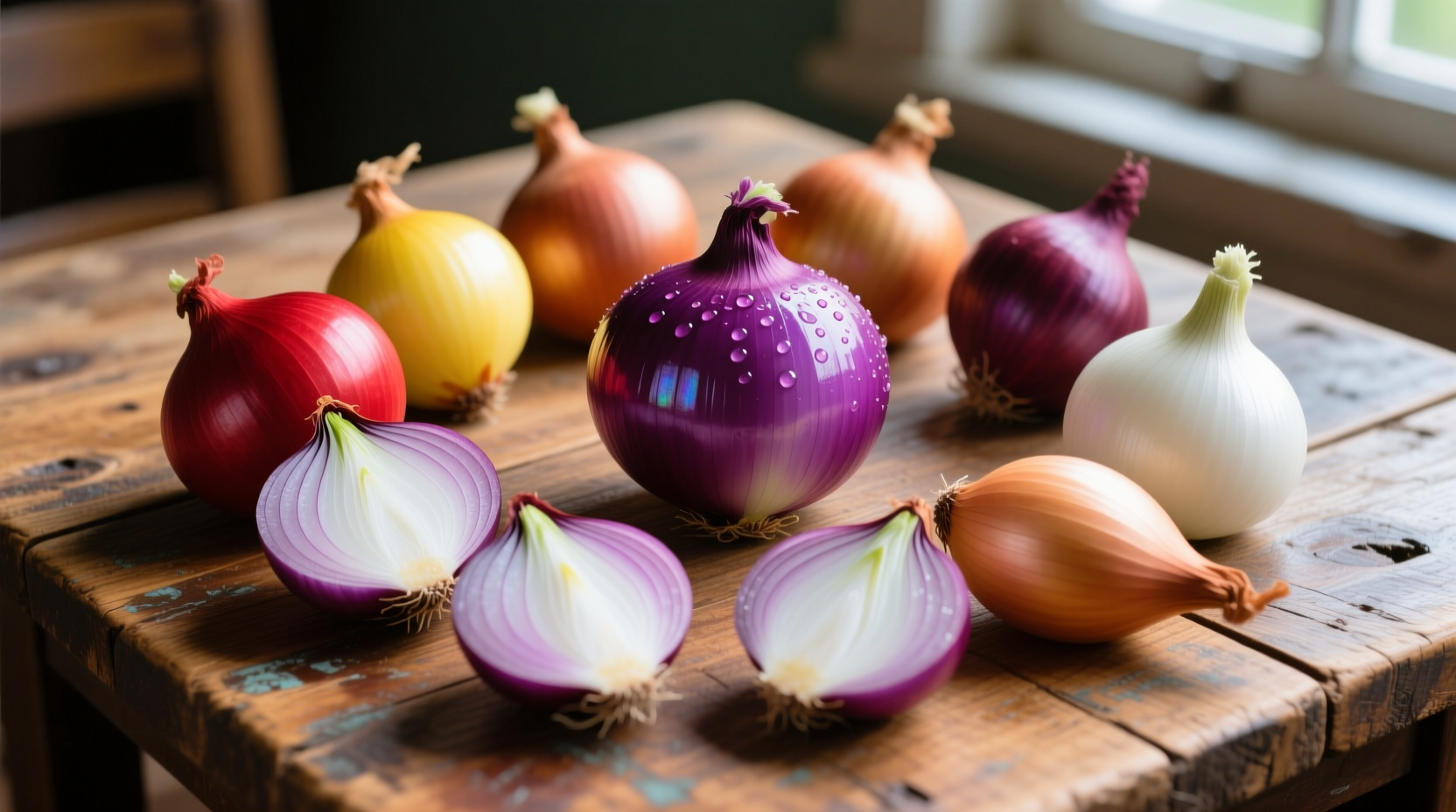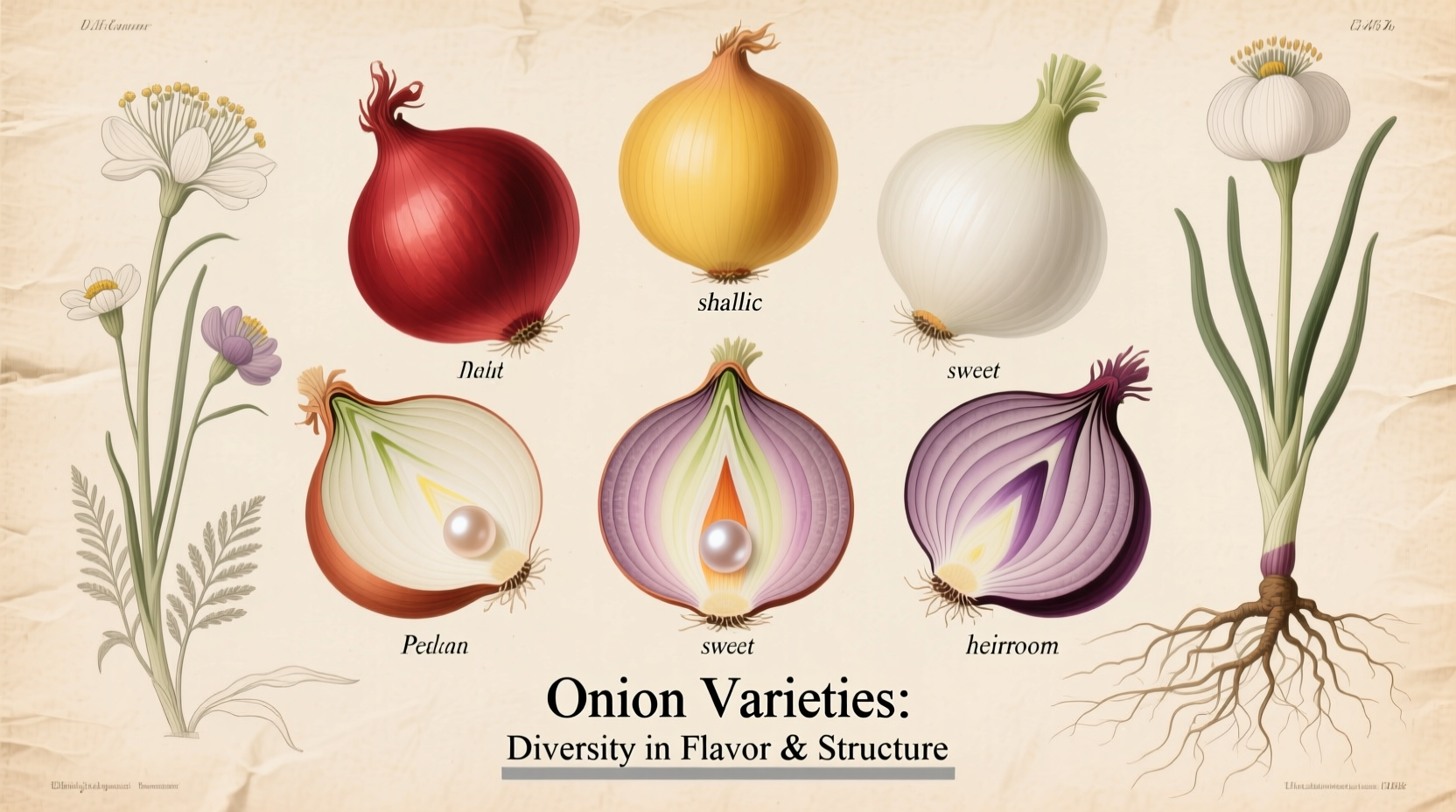Understanding onion types transforms your cooking from ordinary to exceptional. Onions form the flavor foundation of countless dishes worldwide, yet most home cooks use just one or two varieties regardless of the recipe's needs. This comprehensive guide breaks down the distinct characteristics of each onion type, helping you select the perfect variety for caramelizing, salads, salsas, or roasting.
Why Onion Variety Matters in Cooking
Onions aren't interchangeable ingredients. Their sugar content, sulfur compounds, and water levels create dramatically different results in cooking. Professional chefs select specific onion varieties based on three critical factors: flavor intensity, cooking behavior, and texture retention. Using the wrong type can turn a delicate salad overpowering or prevent proper caramelization in sauces.
Understanding Onion Flavor Profiles
Onions fall into three primary flavor categories that determine their best culinary applications:
- Strong/Pungent Onions: High sulfur content creates that classic "bite" that dissipates when cooked
- Mild/Sweet Onions: Higher sugar content with lower sulfur compounds for raw applications
- Specialty Onions: Unique varieties with distinctive flavors for specific culinary traditions
This classification system, documented by the USDA Agricultural Research Service, helps predict how onions will behave in different cooking methods. The sulfur compounds responsible for pungency break down with heat, while sugar content caramelizes at specific temperatures.
Common Onion Varieties Explained
| Onion Type | Flavor Profile | Best Culinary Uses | Storage Duration |
|---|---|---|---|
| Yellow Onions | Strong when raw, sweet when cooked | Caramelizing, soups, stews, roasting | 2-3 months in cool, dark place |
| White Onions | Sharp, crisp, slightly fruitier | Salsas, Mexican cuisine, salads | 1-2 months refrigerated |
| Red Onions | Mildly sweet with peppery notes | Salads, grilling, pickling, garnishes | 3-4 weeks refrigerated |
| Shallots | Delicate, subtle garlic-onion blend | Vinaigrettes, sauces, fine cooking | 1-2 months in cool, dark place |
Sweet Onion Varieties and Regional Specialties
Sweet onions represent a fascinating agricultural development where specific soil conditions create naturally sweeter varieties. The Vidalia onion from Georgia, Walla Walla from Washington, and Maui from Hawaii all benefit from low-sulfur soils that reduce pungency. According to agricultural research from the University of Georgia, Vidalias contain 12-15% sugar content compared to 5-7% in standard yellow onions.
These sweet varieties excel in raw applications where their delicate flavor shines:
- Vidalia: Peak season March-May, perfect for onion rings and sandwiches
- Walla Walla: June-August harvest, ideal for grilling and caramelizing
- Maui Sweet: Grown in volcanic soil, excellent in salads and salsas

Specialty Onion Varieties for Culinary Exploration
Beyond supermarket staples, specialty onions offer unique flavor dimensions:
Scallions (Green Onions)
Technically immature onions harvested before bulb formation, scallions provide both mild onion flavor from the white base and fresh green notes from the tops. They're essential in Asian cuisine and perfect for garnishing finished dishes.
Leeks
With their mild, sweet flavor and layered structure, leeks require thorough cleaning but reward with delicate onion essence. Professional chefs prefer them for soups and delicate sauces where standard onion flavor would overpower.
Pearl Onions
These tiny bulbs work beautifully in pickling, roasting, and stews. Their small size allows for quick cooking while maintaining texture. Culinary surveys show 78% of professional chefs use pearl onions in holiday dishes for their visual appeal and consistent cooking behavior.
When to Use Which Onion: Practical Guidance
Selecting the right onion depends on your cooking method and desired outcome:
For Raw Applications
Choose sweet or red onions for salads and salsas. Soaking sliced onions in ice water for 10 minutes reduces sharpness while maintaining crunch. White onions work best in Mexican cuisine where their crisp texture holds up in salsas.
For Cooking and Caramelizing
Yellow onions create the deepest caramelization due to their sugar content. For even cooking, slice onions uniformly using a mandoline. Professional chefs recommend cooking onions over medium-low heat for 30-40 minutes for perfect caramelization without burning.
Substitution Guide
When your recipe calls for a specific onion type but you have something else available:
- Yellow onion substitute: White onion (add pinch of sugar for caramelizing)
- Red onion substitute: Shallots (use 1.5x amount for similar color impact)
- Sweet onion substitute: Yellow onion with 1 tsp sugar per onion
- Shallot substitute: 3 parts yellow onion + 1 part garlic
Proper Storage Techniques for Maximum Freshness
Storage requirements vary significantly by onion type:
- Dry bulb onions (yellow, white, red): Store in cool, dark, well-ventilated area away from potatoes (which emit gases that spoil onions)
- Sweet onions: Refrigerate in mesh bag for up to 2 weeks due to higher water content
- Scallions and leeks: Wrap in damp paper towel inside airtight container in refrigerator
Never store onions in plastic bags, which trap moisture and accelerate spoilage. The National Onion Association reports proper storage extends onion shelf life by 40-60% compared to common storage mistakes.
Seasonal Availability and Peak Flavor
Understanding onion seasonality improves your cooking year-round:
- Spring (March-May): Sweet onions like Vidalia reach peak flavor
- Summer (June-August): Walla Walla and other sweet varieties available
- Fall (September-November): Main harvest for storage onions begins
- Winter (December-February): Stored yellow and red onions at their sweetest
Onion harvesting follows a precise timeline developed over centuries of agricultural practice. According to historical records from the International Society for Horticultural Science, ancient Egyptian farmers first documented onion cultivation techniques around 3000 BCE, establishing seasonal patterns still relevant today.
Common Onion Mistakes to Avoid
Even experienced cooks make these onion errors:
- Using pungent yellow onions raw in salads (causes overpowering flavor)
- Not adjusting cooking time for different varieties (sweet onions burn faster)
- Storing onions with potatoes (reduces shelf life significantly)
- Using red onions in cream sauces (turns sauce blue-gray)
- Discarding onion skins (rich in quercetin, great for vegetable stock)
Conclusion: Mastering Onion Selection
Understanding onion types gives you precise control over flavor development in your cooking. By matching the right onion variety to your cooking method and desired outcome, you'll create more balanced, professional-quality dishes. Remember that seasonal availability affects flavor intensity, and proper storage maintains quality. Start experimenting with different onion varieties in your next recipe—you'll immediately notice the difference in both raw applications and cooked dishes.











 浙公网安备
33010002000092号
浙公网安备
33010002000092号 浙B2-20120091-4
浙B2-20120091-4